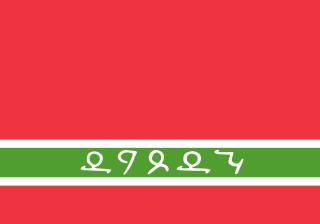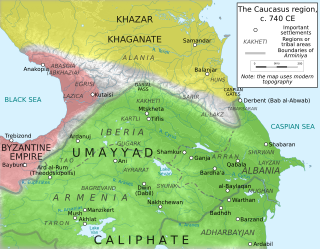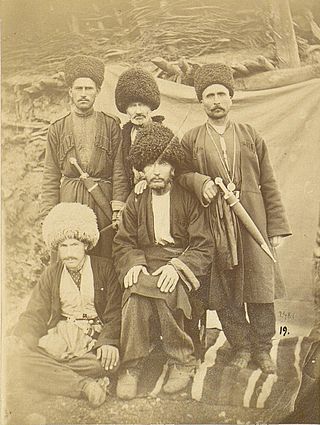
Lezgistan is an ethnic homeland of the Lezgins, as well as the area of distribution of the Lezgin language. [1]

Lezgistan is an ethnic homeland of the Lezgins, as well as the area of distribution of the Lezgin language. [1]
While ancient Greek historians, including Herodotus, Strabo, and Pliny the Elder, referred to Legoi people who inhabited Caucasian Albania, Arab historians of 9-10th centuries mention the kingdom of Lakz in present-day southern Dagestan. [2] Al Masoudi referred to inhabitants of this area as Lakzams (Lezgins), [3] who defended Shirvan against invaders from the north. [4]
Prior to the Russian Revolution, "Lezgin" was a term applied to all ethnic groups inhabiting the present-day Russian Republic of Dagestan. [5]
The first notion of an autonomous Lezgin territory, that is, "Lezgistan", was voiced in 1936 during Joseph Stalin's reign. [6]
After the dissolution of USSR there was an irredentist project to create a unified Lezgistan on Lezgin-inhabited areas of Azerbaijan and Russian Republic of Dagestan. [7] In December 1991, various Lezgin groups held the All-National Congress of Lezgins. During it, they adopted a declaration calling for the creation of an independent Lezgistan, which would be a national entity uniting the Lezgins of Dagestan and Azerbaijan. [8]

Caucasian Albania is a modern exonym for a former state located in ancient times in the Caucasus, mostly in what is now Azerbaijan. The modern endonyms for the area are Aghwank and Aluank, among the Udi people, who regard themselves as descended from the inhabitants of Caucasian Albania. However, its original endonym is unknown.

Derbent, formerly romanized as Derbend, is a city in Dagestan, Russia, located on the Caspian Sea. It is the southernmost city in Russia, and it is the second-most important city of Dagestan. Derbent occupies the narrow gateway between the Caspian Sea and the Caucasus Mountains connecting the Eurasian Steppe to the north and the Iranian Plateau to the south; covering an area of 69.63 square kilometres (26.88 sq mi), with a population of roughly 120,000 residents.

Lezgins are a Northeast Caucasian ethnic group native predominantly to southern Dagestan, a republic of Russia, and northeastern Azerbaijan, and speak the Lezgin language. Their social structure is firmly based on equality and deference to individuality. Lezgin society is structured around djamaat and has traditionally been egalitarian and organised around many autonomous local clans, called syhils (сихилар).

The Tat people are an Iranian people presently living within Azerbaijan and Russia. The Tats are part of the indigenous peoples of Iranian origin in the Caucasus.
Lezgin, also called Lezgi, is a Northeast Caucasian language. It is spoken by the Lezgins, who live in southern Dagestan (Russia); northern Azerbaijan; and to a much lesser degree Turkmenistan; Uzbekistan; Kazakhstan; Turkey, and other countries. It is a much-written literary language and an official language of Dagestan. It is classified as "vulnerable" by UNESCO's Atlas of the World's Languages in Danger.

Dagestan, officially the Republic of Dagestan, is a republic of Russia situated in the North Caucasus of Eastern Europe, along the Caspian Sea. It is located north of the Greater Caucasus, and is a part of the North Caucasian Federal District. The republic is the southernmost tip of Russia, sharing land borders with the countries of Azerbaijan and Georgia to the south and southwest, the Russian republics of Chechnya and Kalmykia to the west and north, and with Stavropol Krai to the northwest. Makhachkala is the republic's capital and largest city; other major cities are Derbent, Kizlyar, Izberbash, Kaspiysk, and Buynaksk.

Arran, also known as Aran, was a geographical name used in ancient and medieval times to signify a historically-Iranian region which lay within the triangle of land, lowland in the east and mountainous in the west, formed by the junction of the Kura and Aras rivers, including the highland and lowland Karabakh, Mil plain and parts of the Mughan plain. In pre-Islamic times, it corresponded roughly to the territory of the modern-day Republic of Azerbaijan. The term is the Middle Persian equivalent to the Greco-Roman Albania. It was known as Aghvania, Alvan-k in Armenian, and Al-ran in Arabic.

Shirvan is a historical region in the eastern Caucasus, as known in both pre-Islamic Sasanian and Islamic times. Today, the region is an industrially and agriculturally developed part of the Republic of Azerbaijan that stretches between the western shores of the Caspian Sea and the Kura River, centered on the Shirvan Plain.
The culture of Azerbaijan combines a diverse and heterogeneous set of elements which developed under the influence of Iranic, Turkic and Caucasian cultures. Azerbaijani culture includes its distinct cuisine, literature, folk art, and music.

The peoples of the Caucasus, or Caucasians, are a diverse group comprising more than 50 ethnic groups throughout the Caucasus.

The history of Azerbaijan is understood as the history of the region now forming the Republic of Azerbaijan. Topographically, the land is contained by the southern slopes of the Caucasus Mountains in the north, the Caspian Sea in the east, and the Armenian Highlands in the west. In the south, its natural boundaries are less distinct, and here the country merges with the Iranian Plateau.

The Tsakhur or Saxur people are a Lezgin sub-ethnic group of northern Azerbaijan and southern Dagestan (Russia). The group numbers around 30,000 people and are called yiqy, but are generally known by the name Tsakhur, which derives from the name of a Dagestani village, where they make up the majority.

Tabasarans are a Northeast Caucasian ethnic group native predominantly to southern part of the North Caucasian republic of Dagestan. Their population in World is about 190,000. They speak the Tabasaran language.
Azerbaijanis in Russia or Russian Azerbaijanis are people of Azeri descent in Russia. These may be either ethnic Azeris residents in the country or recent immigrants who profess Azeri ancestry.
Shirvani Arabic is a variety of Arabic that was once spoken in what is now central and northeastern Azerbaijan and Dagestan.

This article focuses on ethnic minorities in the Republic of Azerbaijan.

Arabs first established themselves in the Caucasus in the eighth century, during the Arab conquest of Persia. The process of shrinking of the Abbasid Caliphate in the tenth century was followed by the establishment of several Arab-ruled principalities in the region, chiefly the principality of Shirvan ruled by the Mazyadid dynasty. As the rulers of Shirvan spread their control over much of the Southeast Caucasus and at the same time found themselves more and more isolated from the Arab world, they were undergoing gradual Persianisation. Arab personal names of the Shirvanshahs gave way to Persian ones, members of the ruling dynasty were claiming Ancient Persian descent and Persian gradually became the language of the court and the urban population, while the rural population continued to speak the indigenous languages of Caucasian Albania. However by the seventeenth century a local Turkic idiom became the language of everyday life, as well as the language of interethnic communication.

The Khinalugs are an indigenous people of Azerbaijan and speak the Khinalug language, a Northeast Caucasian language. The Khinalugs are indigenous to the Quba District and have been named after their main village, Khinalug. It is one of the peoples that have traditionally been called Shahdagh.

Lezgins are the largest ethnic minority in Azerbaijan historically living in some northern regions of Azerbaijan. For most Lezgins, the mother tongue is Lezgin, and minorities have Azerbaijani and Russian as the mother language.

The Sadval movement, or simply Sadval, meaning "Unity"; is a Lezgin political movement, whose initially stated goal was to address the perceived discrimination and marginalization of their community in Azerbaijan. Formed in July 1990 in Dagestan, the Sadval movement addressed issues important to both Russian and Azerbaijani Lezgins. Around the same time, prior to the imminent breakup of the former Soviet Union, other ethnic minority groups in the region began to assert their own cultural and political identities